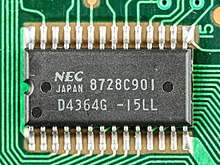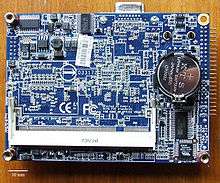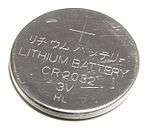Nonvolatile BIOS memory


Nonvolatile BIOS memory refers to a small memory on PC motherboards that is used to store BIOS settings. It is traditionally called CMOS RAM because it uses a volatile, low-power complementary metal-oxide-semiconductor (CMOS) SRAM (such as the Motorola MC146818 or similar) powered by a small "CMOS" battery when system and standby power is off.[1] The typical NVRAM capacity is 256 bytes.[2]
The CMOS RAM and the real-time clock have been integrated as a part of the southbridge chipset and it may not be a standalone chip on modern motherboards.[2]
CMOS battery

The memory battery (aka motherboard, CMOS, real-time clock (RTC), clock battery)[3][4] is generally a CR2032 lithium coin cell. This cell battery has an estimated life of 3 years when power supply unit (PSU) is unplugged or when the PSU power switch is turned off.[5][6] This battery type, contrary to popular belief, is not rechargeable and trying to do so may result in an explosion. Motherboards have circuitry preventing batteries from being charged and discharged when a motherboard is powered on. Other common battery cell types can last significantly longer or shorter periods, such as the smaller CR2016 which will generally last about 40% less time than CR2032. Higher temperatures and longer power-off time will shorten battery cell life. When replacing battery cell, the system time and CMOS BIOS settings may revert to default values. Unwanted BIOS reset may be avoided by replacing battery cell with PSU power switch turned on and plugged into electric socket on the wall. On ATX motherboards, turning on power switch on PSU, will supply 5V standby power to the motherboard to keep CMOS memory energized during computer turned off period.
Some computer designs have used non-button cell batteries, such as the cylindrical "1/2 AA" used in the Power Mac G4 as well as some older IBM PC compatibles, or a 3-cell NiCd CMOS battery that looks like a "barrel" (common in Amiga and older IBM PC compatibles), which serves the same purpose.
See also
References
- ↑ Fisher, Tim. "What is CMOS? (CMOS & CMOS Battery Definition)". About.com. Retrieved 2 September 2015.
- 1 2 "Intel® 100 Series Chipset Family PCH Datasheet". Intel. August 2015. Retrieved 2016-04-16.
- ↑ What are CMOS or Clock Batteries?
- ↑ Ask a question » Replacing the battery of your motherboard (CMOS battery)
- ↑ "The battery has an estimated life of three years when the Intel® NUC is not plugged into an AC power source. When the computer is plugged in, the standby current from the power supply extends the life of the battery; from Google (cmos battery power supply unplugged) page 2 result 3".
- ↑ "find 'power switch' in user manual; from Google (dynex psu) result 5".